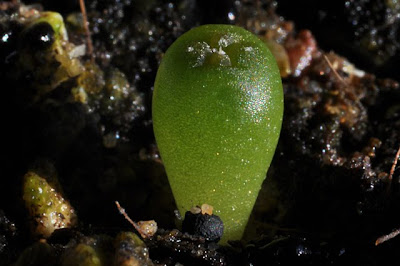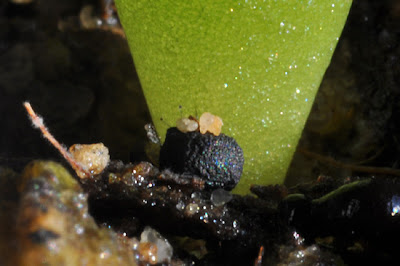This spring I started my “virgin batch” of Lophophora alberto-vojtechii (San Luis Potosí) seeds. L. alberto-vojtechii is a recently recognized species that is not yet commonly cultivated, consequently the seeds are sold at rather steep prices – I bought my 10 seeds for 16 euro (~20 USD) from Köhres-Kakteen.
Lophophora alberto-vojtechii seedling
Unfortunately the germination rate of the L. alberto-vojtechii seeds was rather bad - only one seed in ten germinated. The seeds were sown at the same time and have been growing under exactly the same conditions as the peyote seedlings described in the previous post (which had a good germination rate by the way). So either the quality of the Lophophora alberto-vojtechii seeds were not optimal or they have different germination requirements than L. williamsii (I have to say that in general my experience with Köhres’s seed is good)
Lophophora alberto-vojtechii seedling, top view
The seedling looks exactly like a regular peyote seedling except that it is lacking the tiny, plumose spines, but given the fact that I only have one seedling it’s too early to say if this is a general trait or not.
As mentioned above the species was only recently described and there are some doubts if it’s a good species or not - it’s going to be interesting to see more plants appear in cultivation. That being said, several authorities are vouching for Lophophora alberto-vojtechii as the fifth species of Lophophora: George Hinton collected the type specimen (and keeps it in the G. B. Hinton herbarium filed under number 28642) and in a recent presentation on Lophophora population genetics Martin Terry also treats L. alberto-vojtechii separately from the other species.
Lophophora alberto-vojtechii seedling with spent seed
In the above picture the spent seed can be seen at the foot of the seedling (which is also at the very limit of my macro lens’s capacity ;-)
The plant was started from seed April 5, 2010 and the pictures were taken June 14, 2010 – exactly 10 weeks later (approximately two months after the lone seed had germinated).
Expecting more seedlings to have germinated, I had planned to graft some of them but now I’m having second thoughts, not wanting to risk my sole L. alberto-vojtechii seedling.
Thursday, June 24, 2010
Lophophora alberto-vojtechii seedling pictures
Thursday, June 17, 2010
Peyote seedlings – Big Bend, Texas and Camargo, Chihuahua varieties
Late last year I ordered my first seed ever from Köhres-Kakteen (coinciding with ordering my first ever Lophophora alberto-vojtechii seeds ;-)

Dichotomous peyote seedling (var. Big Bend, Texas)
After this winter’s freezing disaster I’m glad I decided to order seeds of the northernmost form of peyote as this “strain” (a.k.a. Lophophora williamsii var. echinata) is known to be more frost tolerant than other varieties of peyote. For growing in my coldhouse I ordered Lophophora williamsii v Big Bend, Texas and Lophophora williamsii v Camargo, Chihuahua seeds from Köhres’s list – I’m not entirely sure if the Camargo variety classifies as echinata but it originates from the western extremity of peyote’s range, pretty far to the north, so I expect it to be able to “rough it out” in my unheated greenhouse.

Dichotomous peyote seedling (var. Big Bend, Texas), close-up
One of the “Big Bend” peyote seedlings turned out as dichotomous (branching, two-headed). The first time I experienced a dichotomous seedling I was really excited and expected it to continue branching and develop into a crest. Today I know that in a few years I will probably not be able to distinguish it from the other seedlings in the (by then) crowded seedling pot ;-)

Peyote seedling (var. Camargo, Chihuahua) with spent seed husk
The small, feathery spines are typical for Lophophora williamsii seedlings – according to Boke and Anderson seedling tubercles bear three to six plumose spines, numbers that correspond well with what I observe in my seedlings (the odd areole having seven spines). With age these spines are gone, replaced by tufts of trichomes.
The plants pictured above were started from seed April 5, 2010 and the pictures were taken June 14, 2010 – exactly 10 weeks later (approximately two months after most of the seed had germinated).
Sunday, June 13, 2010
Sharkwater - Stop Shark Finning
What is Shark Finning?
- Shark finning refers to the removal and retention of shark fins and the discard at sea of the carcass. The shark is most often still alive when it is tossed back into the water. Unable to swim, the shark slowly sinks toward the bottom where it is eaten alive by other fish.
- Shark specialists estimate that 100 million sharks are killed for their fins, annually.

A whale shark fin on display outside of a shark fin restaurant, with shark fin soup preparation in the background. Bangkok, Thailand. Photo by Rob Stewart
A whale shark had its fins cut off while still alive, then left to die
Shark fin is a popular delicacy in Asia - especially China, where it is typically served in shark fin soup at weddings, business dinners, etc. Shark fins are big business, allegedly a bowl of shark fin soup can fetch up to $120! Consequently sharks are killed in the millions (as mentioned above some experts estimate 100 million sharks are killed each year), diminishing the populations alarmingly fast - some to the point of extinction. On top of that the sharks are killed in an extremely cruel way, the fins are usually sliced off as the shark is still alive and the finless body is dumped back into the ocean left to a slow death.
Concerned voices are also raised regarding how the ecosystems of the ocean will be affected by removing massive numbers of top-level predators. The IUCN Shark Specialist Group Finning Statement says: "shark finning [...] threatens many shark stocks, the stability of marine ecosystems, sustainable traditional fisheries, food security and socioeconomically important recreational fisheries" and concludes that "a ban on shark finning is justified throughout the world’s oceans and high seas".
Not to mention the tremendous waste: the IUCN Information Paper on Shark Finning states that "The most widely used fin:carcass ratio was developed by the US National Marine Fisheries Service (NMFS) in the early 1990s. NMFS adopted a ratio of 5% fin weight to 95% dressed (gutted and beheaded) carcass weight based on samples of sharks dressed at sea under commercial fishing conditions in the Northwest Atlantic, and using the ratio appropriate for species with the largest fins", meaning that less than 5% of the killed animal is actually used.

Dusky shark attacking school of sardines in South Africa. Photo by Peter Lamberti
The screening of Sharkwater was followed by an analysis by a shark biologist from my old university. Asked if Sharkwater should be considered a sober or exaggerated "eco documentary" she replied that the situation as described by Rob Stewart is very much for real - millions of sharks are killed each year for their fins and many species will become extinct if action is not taken now!
It's sad to see how these magnificent creatures have gone from predator to prey, and how despite surviving the earth's history of mass extinctions, they could easily be wiped out within a few years due to human greed.
The stupidity and shortsightedness of mankind can be dumbfounding.
References
Sharkwater - The Truth Will Surface
IUCN Information Paper on Shark Finning
IUCN Shark Specialist Group Finning Statement
SavingSharks.com
The photos are taken from the Sharkwater Press Kit

Scalloped hammerhead shark, Cocos Island, Costa Rica. Photo by Rob Stewart
Tuesday, June 08, 2010
Flowering Normanbokea valdeziana (Turbinicarpus valdezianus)
My coldhouse grown Normanbokea valdeziana plants (SB 1468; Ramos Arizpe, Coahuila, Mexico) have flowered before but I’ve never had the chance to actually experience the bloom until a few weeks ago.

Flowering Normanbokea valdeziana
The petals are a pinkish white with a darker magenta midstripe, giving me strange associations to candy canes ;-) The filament and stigma are pure white while the anthers are a bright yellow. The flower is huge compared to the body of the plant, completely hiding it when seen from above.

Normanbokea valdeziana flower hiding plant
Normanbokea valdeziana is slow growing and its tiny feathery spines almost completely obscure the body of the plant – it is said to sometimes form clusters but all of my plants are solitary.

Normanbokea valdeziana flower
This species is capable of surviving hard, extended frost – all of my plants even made it through last winter’s extremely cold conditions without any damage.
Sukkulentarium Muthandi recently featured five flowering Normanbokea valdeziana plants, all displaying fairly different flowers.
All Time Most Popular Posts
-
Lophophora williamsii (peyote) populations have diminished in large areas of South Texas where peyoteros harvest the cactus for ceremonial ...
-
On various occasions I've been asked what growing media I'm using for my cactus plants. I don't have a set soil mix recipe as su...
-
Below is a list of retailers/nurseries selling cactus seed and plants. I've only listed vendors I've done business with. If you ar...
-
Most cacti are easily grown from seed - and with a little patience and care they can be grown into beautiful plants. Lophophora williamsi...
-
In last month’s post on the troubled Texan peyoteros I referred to Anderson’s article on the peyote situation in Texas. Given the importanc...
-
Yet another slightly off topic and probably not entirely politically correct post, but I couldn’t help noticing the similarity of my monstr...
-
Flowering stand of San Pedro cacti (Trichocereus pachanoi) To me the main draw of the San Pedro cactus ( Trichocereus pachanoi (syn. Ech...
-
In the June 2008 issue of the Cactus & Co magazine Jaroslav Šnicer, Jaroslav Bohata, and Vojtěch Myšák described a new Lophophora spec...
-
There seems to be an increased focus on the alarming Texas peyote situation. A couple of weeks ago the Houston Press published a mournful, i...
-
I spent two weeks working in Delhi, India during January. I had one weekend off and had planned to spend it in Delhi at my own leisure, but ...


















